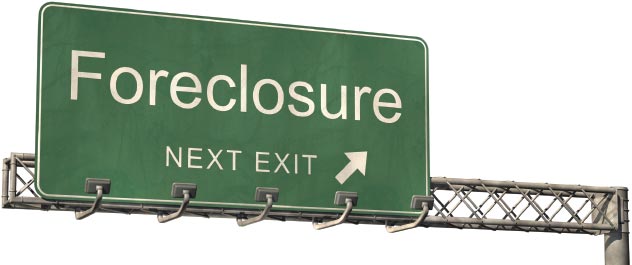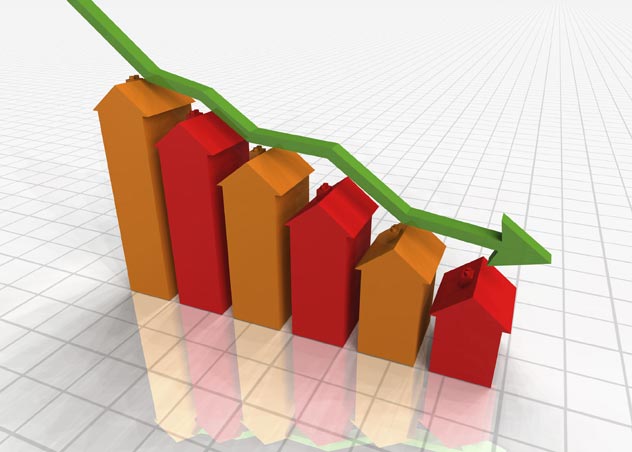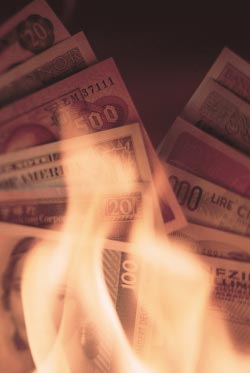COVER STORY
Subversive Subprimes: The Political Economy of the Financial Crisis
Dodgy loans, former Fed chief Alan Greenspan’s dubious backing of a go-go housing bubble, murky financial instruments that have spread the liability all over the world, and an underlying bias in the financial infrastructure that privatizes profit and socializes the gargantuan losses by taxpayer bailouts have created an unholy mess, writes Ashok Bardhan.
“Just as there are no atheists in a foxhole there are no free-marketers in a financial crisis.”
— Overheard in the markets

Introduction
The U.S. economy is in the early stages of what looks to be the worst financial and economic crisis since the Great Depression. While at present it is mostly the financial side that has the jitters and the real economy still appears to be sputtering along at an anemic rate of growth, the latter is very likely to slip into recession in the near future. Barely a day passes without yet another financial firm flirting with insolvency, a new low in housing prices and sales, and a further downturn in the stock market, the only uptick being the increase in our collective knowledge of arcane financial instruments.
Certainly it is rare to have so many different storms buffeting the economic ship all at once, and the list seems to get longer with every passing month. The sub-prime crisis and the sudden and rapid downturn in the housing market were the harbingers of a broader real estate and housing finance crisis. The malaise has now reached the government-sponsored enterprises — Fannie Mae and Freddie Mac, which are the lynchpins of the housing finance system. In turn, the broader housing finance crisis has now affected other debt markets such as municipal and corporate bonds, the unsecured loan markets for auto, credit card and student loans, and the murky world of financial derivatives (complex financial instruments derived from simpler underlying ones). The stock market has also started to falter. The infection of the entire financial system is therefore complete and total.
At the same time, after lying low for a couple of decades, the threat of world-wide inflation has reappeared with fuel, commodity and food prices experiencing the most rapid increases over the past quarter century. To add a further element of uncertainty and vulnerability to the global economic scenario, there is the ongoing churning in the labor market brought about by globalization and offshoring. The United States has also been running massive current account deficits financed by foreign capital flows, in which China, Japan and oil exporting countries play the role of leading creditors. With an already weakening dollar, this policy of dependence on foreign creditors to sustain domestic consumption and housing binges is fraught with risk and leads to a precarious situation, where all the sundry creditors are looking over each other’s shoulders to see who is going to bolt first and lead a mad rush for the exit, making the dollar crash precipitously. While this time it is the U.S. that is at the epicenter of the financial earthquake, the ripples and aftershocks have been continuous and are being felt globally.
Is it a coincidence that all the crises have erupted simultaneously or is there a connection, however tenuous, between them? Is the multiplicity of crises yet another testament to the power and evolving nature of globalization?

The Evolution of the Current Crisis
The genesis of the current crisis lies, as is so often the case, in developments related to the real estate sector, more specifically its housing or residential segment. In any country, the health of the housing sector is a critical indicator of the health of the economy at large. This is due to a number of factors, including the size of the sector, its linkages to other sectors in the economy, and the social and political implications of an industry that straddles the family, the community and the economy.
Housing and home ownership have long constituted one of the bedrocks of the U.S. social and economic system. From a sociological point of view home ownership is believed to promote community-based values, nurture respect for law and order, and provide a stake in the stability and prosperity of the system; from an economic point of view, the hopefully steady appreciation of home values, the main asset holding of a household, would provide the basis for a continuous boost in consumption, the driving force/engine of the U.S. economy.
Starting with the depression era, the housing finance system has evolved into a host of agencies designed ultimately to keep the cost of homeownership low, stable and secure. These include the Federal Housing Administration which insures commercial mortgage lenders against mortgage losses; the Federal Home Loan Banks which provide local liquidity to financial institutions, particularly for affordable housing; the U.S. Department of Housing and Urban Development, whose explicit mission is to increase home ownership; and of course Fannie Mae and Freddie Mac. The last two institutions are strange hybrid beasts, with a private ownership structure but government backing for liabilities, and with social objectives (the promotion of home ownership) as their mission. The “implicit” government backing guaranteeing their debt enables these agencies to raise money relatively cheaply. The net economic effect of the agencies is twofold; first, their activity keeps mortgage rates lower than would otherwise have been the case, and second, they slice lumpy real estate loans into investible bites (akin to stock certificates) thus dispersing risk and ownership.
The past decade has seen an unprecedented run-up in house prices. Historically low interest rates (on which more later) created a conducive economic environment for borrowing, while lax lending standards set up an accommodating institutional setting. Some more substantive reasons for the boom can also likely be attributed to the appearance of the largest, most affluent foreign-born cohort in U.S. history (a phenomenon most prevalent in coastal regions of the US), which also happened to belong to the optimal home-buying demographic. The home ownership rate (percentage of households owning their homes vs. renting) showed a similar growth pattern through the 1990s, helped along by subprime loans often involving no down payment, low initial teaser rates and even waivers on income documentation. In 2006, the last year of the housing boom, the share of sub-prime mortgages in total mortgage originations reached 20 percent compared to only 6 percent in 2002. Over 80 percent of these dodgy loans were promptly pooled and securitized by private financial institutions; however, this process of securitization, while doing an admirable job of generating liquidity for lumpy, non-liquid assets, did not just disperse risk but also distanced mortgage originators from the ultimate investors in mortgage securities. Ultimately, it led to risk doubly compounded — the most risky borrowers were sought out, offered mortgages on easy terms, which were then precisely the mortgages that were securitized, leaving investors in far-off lands holding securities they knew little about, and whose funds now generated more mortgages and higher house prices.

By the second half of 2006 prices had peaked in most U.S. urban housing markets. Early 2007 witnessed significant increases in defaults and foreclosures, and a number of financial companies started filing for bankruptcy. By summer the crisis had spread to the larger financial system with the emergence of a general credit and liquidity crunch, widening spreads of private market interest rates above U.S. government bond yields, collapsing transactions in derivatives and a disappearing market for loans of all kinds. Mounting losses in the financial sector continued in 2008 with Bear Stearns an early victim, and reports appeared of more brokerage houses in serious financial trouble. The apogee of the crisis was reached with the stocks of Fannie and Freddie plummeting over several days in July and ultimately losing over 80 percent of their value. By our estimate, at present more than 15 million homes have no equity in them since a large number of houses were bought with less than a 20 percent down payment and home prices have declined by more in many metropolitan areas. Having zero or negative equity provides the affected homeowners with a powerful incentive to abandon these white elephants and move into rental housing, further depressing the housing market. Taking the costs involved in the entire foreclosure process, including holding and disposal costs, and making conservative assumptions as a benchmark, the losses to the financial system would be of the order of $300 billion from this “event” alone. Notional housing wealth has already taken a hit, of say $5 trillion, because of declining prices. To put all these astronomical figures into a meaningful perspective it is worthwhile noting that the GDP of the U.S. for 2007 was approximately $13.8 trillion.

Sub-priming the Financial Pump: The Factors Underlying the Crisis
The fungibility and deep interconnectedness of the entire financial system was underscored by the rapidity with which subprime woes were exported to other areas of the financial system. The desperate efforts of the Federal Reserve to jump start credit markets by lowering short-term interest rates, while helping avert total rout in the financial markets has not succeeded in the face of a generalized crisis of confidence in the soundness of the financial system. The key interest rates that matter for investment and consumption are the long-term ones and they have refused to edge down in a spreading credit crunch environment.
What are the factors behind this seemingly sudden state of affairs? As with many other phenomena, this crisis has been quite a while in the making. We should be clear that the entire universe of subprime loans is not socially harmful. A certain leniency in the strict rationing of bank credit, as well as institutional arrangements that can lower mortgage costs can give people, who would otherwise find it difficult to get a mortgage, the opportunity to own a home. Neither is a bump up in home ownership rates necessarily a deleterious economic or social event. Indeed, U.S. housing policy shows that subsidies work; wealth inequality in the U.S. would be even higher were it not for the significant level of home ownership. The point however, is that the driving force behind this recent development was not a deliberate, socially constructive policy but a phenomenon born of other structural motivations embedded in the system.
Preference for an economic ideology that stresses an asset-ownership based model of compensation and standard of living, rather than one based primarily on salary or wage based earnings is subtly promoted. The daily obsession with stock markets, housing prices and other assets, regardless of the often miniscule share of equity owned by most people, is stoked by neo-liberal economists who extol the virtues of an ownership society to the detriment of fair, living wages, which has to be the foundation of any progressive economic policy. The credit-fed boom in housing created illusory wealth to the tune of trillions of dollars, leading to further borrowing for consumption purposes and to a cycle of ever higher prices drawing in more credit, buyers and consumers. While an asset price bubble can impart a transient feel-good glow, one cannot get away from a widely felt perception that the financial sector has now transitioned to fulfilling a system-wide need for sequential bubbles, as a key avenue to generate windfall profits in the absence of any dramatic innovations or productive investments taking place in the economy. This is particularly true of a real estate bubble; while the dot-com bubble created some new kind of value — the Googles etc., the present run-up reflects merely an unproductive form of capital accumulation. The excessive risk-taking and the proliferation of speculative instruments belies the traditional role of the financial sector and reflects a mismatch between fund availability and productive and profitable investments in the developed world. At the macro-level of the economy, the bubbles are justified as long as they are in inflating mode, since they serve as engines of growth by boosting consumption driven by borrowings against the paper wealth created.
In terms of pure economic/financial root causes, one can cite the savings glut in emerging economies, channeled to the U.S. through the medium of international capital flows, and leading to excessive liquidity and low interest rates. The “cheap money” environment fostered a frantic search for higher returns, leading to higher risk taking and high leverage (huge debts on the buy side), as well as corner cutting (on the sell side). Securitization, the influx of new investors, and an incentive structure that rewarded new deals meant that there was a proliferation of a sequential turnover of deal-making and debt dispersal — let someone else be left holding this toxic stuff when the ceiling comes crashing down. The bandwagon effect thus generated led to a swift, and what seemed prolonged bubble in asset prices, not just in housing, but also in bonds and commodities. The sustaining fuel for this towering house of cards was the steady and robust growth in house prices, and at the first sign of weakness in the housing market the entire structure began to unravel. The complex character of some of the financial instruments served to hide the fact that a subtle subversion of the fundamental objectives of the financial system, to wit, allocation of savings to investors and risk mitigation, was under way, objectives that were undermined not just by routine speculative activity but by naked gambling. For example, some esoteric securities, also called credit default swaps, involve a contract between two parties, wherein one makes payments to the other and receives the promise of a payoff if a third party defaults. The separation of the economically relevant party from the transaction can deprive the act of substantive sense and leads to the ridiculous situation where the outstanding amount of such contracts, reportedly in excess of $50 trillion, dwarfs most other economic variables. The economic benefit of many such transactions, albeit not all, is unclear, to put it mildly.
Following the money trail is yet another way of uncovering the motivating factors underlying the political economy of this crisis. Alan Greenspan, the former Fed Chairman, kept interest rates low for a considerable length of time, thus mis-pricing risk economy-wide, but enabling Wall Street to operate at low cost. Just as occurred in formerly socialist countries, where below market clearing prices served as a form of subsidy to consumers, here one of the key prices in the economy — the price of money itself — was subsidized to the benefit of private equity funds, (which rely heavily on borrowed money to fund acquisitions), hedge fund operators (who also take on enormous leverage, i.e. operate on borrowed money) and sundry other investors. In effect, the financial system evolved from providing subsidies to the home-owning class to showering subsidies on the investor class. And of course, in the case of massive failure and mismanagement, there was to be, as a final gift from the powers on high, a guaranteed taxpayer-financed bailout.
 The financial system has long had the peculiar status of being both the dynamic core as well as the Achilles’ heel of a modern market economy. The weakness arises, among other things, from the contradiction between the financial system’s regulatory needs and the capacity and propensity for subtle government intervention on behalf of big investors, as well as the potential for recurring asset bubble crises for reasons mentioned earlier. One can fairly authoritatively conclude that there will be greater role of the state and government institutions in future, not just due to the structural possibility of recurrence of crises, but the dramatic increase in financial complexity and its regulatory requirements, the increasing range of conflicting interests, and issues of inequality and fairness. The bailouts of Fannie and Freddie and the role of foreign public sector wealth funds in rescuing private U.S. financial companies are part of a growing trend of effective nationalization. In the case of Fannie Mae, the process is actually re-nationalization (since it was a public sector entity before 1968), albeit not openly expressed as such, and often presented as a prelude to re-privatization. Presumably, in the event of another crisis, the pattern will be repeated and future investors will be bailed out again, leading to re-re-nationalization and so-on and so forth! The financial system has long had the peculiar status of being both the dynamic core as well as the Achilles’ heel of a modern market economy. The weakness arises, among other things, from the contradiction between the financial system’s regulatory needs and the capacity and propensity for subtle government intervention on behalf of big investors, as well as the potential for recurring asset bubble crises for reasons mentioned earlier. One can fairly authoritatively conclude that there will be greater role of the state and government institutions in future, not just due to the structural possibility of recurrence of crises, but the dramatic increase in financial complexity and its regulatory requirements, the increasing range of conflicting interests, and issues of inequality and fairness. The bailouts of Fannie and Freddie and the role of foreign public sector wealth funds in rescuing private U.S. financial companies are part of a growing trend of effective nationalization. In the case of Fannie Mae, the process is actually re-nationalization (since it was a public sector entity before 1968), albeit not openly expressed as such, and often presented as a prelude to re-privatization. Presumably, in the event of another crisis, the pattern will be repeated and future investors will be bailed out again, leading to re-re-nationalization and so-on and so forth!
The role of governments worldwide is set to increase for other reasons, as well. The onset of food and commodities-caused inflation has brought back fears of a 1970s style stagflationary environment, with the worst of both worlds — high inflation coupled with a global slowdown/recession. In the case of developed economies, the pressure on creation of well-paying jobs because of the phenomenon of offshoring/globalization, and productivity problems associated with increasingly service-oriented economies with their winner-take-all occupations portend serious economic and political problems for governments.
The two connecting threads that run through this entire smorgasbord of crises can be simply described as the transformative impact of the rapid growth of emerging economies (India and China in particular) on the one hand, and the weakening role of the U.S. dollar as the fulcrum in the global financial system, on the other. The crucial benefit of the international role of the dollar to U.S. economic and foreign policy is underscored by the various economic, financial and politico-military means employed to buttress it. The flux in the global financial environment reflects the tectonic restructuring taking place in the global economy. The birth-pangs of a new alignment of economic powers are being felt with each hiccup and tremor. In this sense, the spreading financial crisis and the coming global slowdown can be termed the first major crisis of the era of modern globalization. While the sub-prime crisis may not have anything to do directly with the emerging economies, the growing funding role of the latter in international capital flows can certainly be counted as a facilitating condition for keeping interest rates low in the U.S. and feeding the lending frenzy. The need for sound global political management of the crisis will be felt soon enough. Giving free-market space to emerging economies and their continued growth has to be reconciled with lowered expectations in the advanced countries and with bubble- and currency-based propping up of living standards. While a recession in the U.S. is probably underway, a global depression in the manner of the 1930s is unlikely, again due to the intrinsic strength of many of the large emerging economies. However, a prolonged slowdown, or growth in fits and starts, or sputtering recoveries are all on the cards.
|